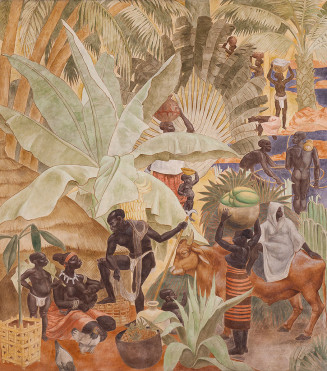Pierre-Henri Ducos de la Haille
The fresco that decorates the forum in the very centre of the Palais de la Porte Dorée, the former function room during the Colonial Exposition of 1931, was created on a surface area of over 600 m² by the painter Pierre-Henri Ducos de la Haille (1889-1972), a professor at the École des Beaux-Arts in Paris, and his seven assistants whose names can be read to the left of the entrance, along with those of his students.
Legende
Pierre-Henri Ducos de la Haille, 1922
Credit
© Agence de presse Meurisse
Born on July 26th 1889 in Poitiers, Pierre-Henri Ducos de la Haille spent his youth between this town with its rich artistic heritage and the Île d’Oléron, where his family owned a house. He settled in Paris in the early 20th century and entered the École Nationale Supérieure des Beaux-Arts in 1909. There he became a student of Raphaël Collin, who notably made a name for himself through the decorative painting of allegorical figures for the Théâtre de l’Odéon and the Opéra-Comique.
After completing his military service in Algeria from 1912 to 1914, Ducos de la Haille was mobilised during World War 1 and was wounded in combat. On returning to Beaux-Arts in Paris in 1919, he followed the teaching of the post-impressionist painter Ernest Laurent whose production was essentially made up of portraits of women but also included allegorical decorative panels for the entrance hall of the great amphitheatre at the Sorbonne.
At Beaux-Arts, Ducos de la Haille also joined the workshop of Paul Baudoüin, the driving force behind the revival of the fresco technique in France. He produced his first frescoes La Mer and La Terre on this occasion, for the boys’ school in the Rue des Jeûneurs in Paris.
In 1922, Ducos de la Haille was awarded the Prix de Rome for painting for his creation on the set theme of Fortune and abundance emerged from the furrow dug by the ploughman. Between 1923 and 1926, he was a resident at the Villa Médicis, where he became friends with the sculptors Louis Bertola and Alfred Janniot.
After returning to Rome, in 1928 Ducos de la Haille produced the fresco for the municipal council room at Reims city hall, structured around the central figure of the Republic draped in purple. She is surrounded by the allegories of Peace and Work, respectively contemplating an agricultural landscape and the reconstruction of the city of Reims.
In 1929, he created the fresco L’âge d’or for textile industry captain Pierre Haussy. The Maison d’Haussy, located near Lille, is the result of a collaboration between the painter, architect Roger-Henri Expert, sculptor Carlo Sarrabezolles and ironworkers Edgar Brandt and Raymond Subes.
That same year, Ducos de la Haille replaced Paul Baudoüin as fresco professor at Beaux-Arts in Paris. Viewed at the time as the master of the fresco technique and an artist sensitive to the “colonial spirit” as a result of the years he spent in Algeria, he was asked by architect Albert Laprade to create a 600-m2 fresco on the theme of France’s contribution to its colonies for the function room at the Palais Permanent at the 1931 International Colonial Exposition.
Inaugurated in May 1931, the fresco features allegorical figures, largely inspired by the ones at Reims city hall, along with colonial scenes that he created in collaboration with another of Baudoüin’s students, Etienne Hauville. Exhausted by six months of intense work, Ducos only took on two more frescoes after that, one in 1932 for the Mondor mansion in Cognac on the theme of the Four Seasons, which was destroyed during World War 2, and another in 1933 for the ceiling of the nave at the Église Saint-Pierre-de-Chaillot in Paris.

Legende
Illustrative composition of work - Fresco in the Forum of the Palais de la Porte Dorée
Credit
Photo : Lorenzö © Palais de la Porte Dorée

Illustrative composition of peace - Fresco in the Forum of the Palais de la Porte Dorée
Lorenzö © Palais de la Porte Dorée
In 1934, he took part in the decoration of the Normandie ocean liner for the Compagnie Générale Transatlantique. For the walls of the first-class gallery-lounge he painted two mounted canvases, Conquête Normande and Paix Normande. They were conserved after the liner was scrapped in 1941 and can still be viewed in the entrance hall of the Normandie Court apartment building in New York City.
From 1935 until the 1950s, Ducos de la Haille took an interest in the art of tapestry. For the Manufacture Nationale des Gobelins he made large tapestry cartoons on the theme of colonial rivers: Le Mékong, Le Niger and La lagune de Madagascar. The postures of the allegories of the Mekong and Niger resemble the allegories of Asia and Africa on the fresco at the Palais de la Porte Dorée. He painted other tapestry cartoons after the war for the Dijon and Versailles chambers of commerce, and for the ocean liners L’Ile-de-France, La Liberté and Le Flandre.
Ducos de la Haille retired in 1959, at the age of 70, in Saint-Martin-de-Ré in the company of Mr. and Mrs. Bertola. He died there on January 19th 1972. He is buried at the Château-d’Oléron alongside his family. The Musée d'Art et d'Histoire in Cognac has conserved a large series of works painted by the artist, thanks to a bequest from the Mondor family. The large formats, such as Le bain des éléphants painted the same year as the Palais de la Porte Dorée fresco, were entrusted to the Musée Sainte-Croix in Poitiers, the painter’s hometown.



